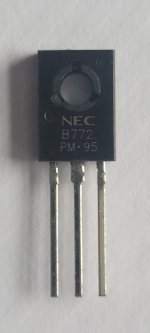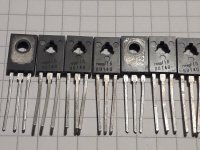I did tested them they're PNP bd140(hfe 360) and NPN bd139(hfe 260), but there HFE values are very different and not as per datasheet from philips .Would an NPN and a PNP ever have the same production code? Have you actually measured them to see if they at least are N and P devices?
There HFE values indicates that they might be fake or counterfeit
I need to know about original die size, not and marking on the case. It would be helpful if you or someone who have the such information about die area and size of bd140 bd139 in picturesHere is a picture of NXP BD139 sold by US seller.
I correct myself, I did not see the spot into the bigger square which I thought was the die de-soldered.I see the die is not such a very small one, and looks like original.
Excuses.
All this talk of Fake BD139/140 ...
I don't understand why this problem is found, when BD139 and 140 are still current manufacture....
I mean, I have a few hundred, OnSemi, genuine devices, bought from trusted distributors, and I sell them on ebay.
not every seller on eBay is flogging fakes
I don't understand why this problem is found, when BD139 and 140 are still current manufacture....
I mean, I have a few hundred, OnSemi, genuine devices, bought from trusted distributors, and I sell them on ebay.
not every seller on eBay is flogging fakes
I kind of agree.
I have posted my page before but don't like plugging myself.
I don't really sell very much in general. The last few weeks in 2020 I have been making 2 or 3 orders a week, which still isn't much, but far more than I have sold prior to that.
I've had 100 odd submini tubes for the best part of 3 years! Maybe 30 left.
So not a great business model. 😆
I have quite a lot of General Purpose transistors,
And I have no qualms about buying and using some Asian manaufacture generics, such as KEC, Unisonic, Semtech.
Where I sell generics the brand is listed, unlike a great deal of ebay sellers. Most state unbranded. Avoid those listing like the plague.
I don't think too many here trust these manufacturers, but I have found no issue with any I use.
I clearly state manufacturers, and have sold few generics, but more western branded stuff, so clearly there is a phobia about Asian devices, which in many cases, e.g. jellybean stuff (2N5401, 2N4401, BC557C, C1815) is almost completely unfounded.
I have posted my page before but don't like plugging myself.
I don't really sell very much in general. The last few weeks in 2020 I have been making 2 or 3 orders a week, which still isn't much, but far more than I have sold prior to that.
I've had 100 odd submini tubes for the best part of 3 years! Maybe 30 left.
So not a great business model. 😆
I have quite a lot of General Purpose transistors,
And I have no qualms about buying and using some Asian manaufacture generics, such as KEC, Unisonic, Semtech.
Where I sell generics the brand is listed, unlike a great deal of ebay sellers. Most state unbranded. Avoid those listing like the plague.
I don't think too many here trust these manufacturers, but I have found no issue with any I use.
I clearly state manufacturers, and have sold few generics, but more western branded stuff, so clearly there is a phobia about Asian devices, which in many cases, e.g. jellybean stuff (2N5401, 2N4401, BC557C, C1815) is almost completely unfounded.
Last edited:
No,I think the issue raised here is obvious fakes which are marked NXP brand but are obviously not NXP brand. The photos show they are marked NXP and the photos also clearly show they are 100% fake.
The real issue is trying to buy NXP, attaching Philips reputation to that, and then trying to source that specific manufacture device, for its mystical qualities.
In this case, BD139/140 which are still produced by 2 major manufacturers.
Don't get me wrong, I am aware that some things are just not made the way they were, but I also understand that actually, in the main, material cost pressures affect all brands equally, and quality of ANY brand is lesser.
Put it this way.
A generic that is 99% the original, is better than a fake that is maybe reject wafer, or any wafer inside.
All the stuff I have used, has actually been incredibly consistent in characteristic parameters
tbh far far more so than what seems to be sought after, rare vintage Toshiba, Sanyo, Sanken - of these the Toshiba I have are consistent. The rest? Big spreads.
Last edited:
Nonsense. Someone posted pictures of devices clearly marked "NXP". Those devices are clearly fake and are not made by NXP or any reputable manufacturer for that case.
That is the issue: https://www.diyaudio.com/community/threads/my-transistors-original-or-copy.82638/post-6934869
The pictured devices are not STM, not Onsemi/Fairchild and most certainly not NXP even though they are marked NXP. They are the typical fakes from the typical fake vendors and contain a tiny/microscopic small signal transistor die with much lower current capability than a BD139/BD140. Hence the abnormally high hFE at the low test current of the meter.
If you want STM go ahead. But it should be marked STM not NXP.
If you want Onsemi/Fairchild go ahead. But it should be marked Onsemi/Fairchild not NXP.
If you want UTC go ahead. But it should be marked UTC not NXP.
If you want another vendor go get what you want. But don't mark it NXP. And don't try to confuse the issue with a claim of mystical properties for one particular vendor.
That is the issue: https://www.diyaudio.com/community/threads/my-transistors-original-or-copy.82638/post-6934869
The pictured devices are not STM, not Onsemi/Fairchild and most certainly not NXP even though they are marked NXP. They are the typical fakes from the typical fake vendors and contain a tiny/microscopic small signal transistor die with much lower current capability than a BD139/BD140. Hence the abnormally high hFE at the low test current of the meter.
If you want STM go ahead. But it should be marked STM not NXP.
If you want Onsemi/Fairchild go ahead. But it should be marked Onsemi/Fairchild not NXP.
If you want UTC go ahead. But it should be marked UTC not NXP.
If you want another vendor go get what you want. But don't mark it NXP. And don't try to confuse the issue with a claim of mystical properties for one particular vendor.
BD139 and 140 can measure high HFe at low collector current and low Vce., and in some cases can appear to exceed Hfe bounds by maybe 10%.
More than that 10% is perhaps suspect
Agreed.
I also have posted about some NEC which look to me to be real, but I doubt.
No response at all lol. Maybe they're real and I'm the only person to have have a lucky buy on eBay 🤣
B772 and D882, gain and capacitance seem to be nominal, and they don't have the "PM 95" batch code, which I have seen everywhere so I assume is one recycled continually on counterfeits.
See below for suspicious "PM 95" date code that seems to be everywhere
More than that 10% is perhaps suspect
Agreed.
I also have posted about some NEC which look to me to be real, but I doubt.
No response at all lol. Maybe they're real and I'm the only person to have have a lucky buy on eBay 🤣
B772 and D882, gain and capacitance seem to be nominal, and they don't have the "PM 95" batch code, which I have seen everywhere so I assume is one recycled continually on counterfeits.
See below for suspicious "PM 95" date code that seems to be everywhere
Attachments
Last edited:
No sir.No,
The real issue is trying to buy NXP, attaching Philips reputation to that, and then trying to source that specific manufacture device, for its mystical qualities.
In this case, BD139/140 which are still produced by 2 major manufacturers.
Don't get me wrong, I am aware that some things are just not made the way they were, but I also understand that actually, in the main, material cost pressures affect all brands equally, and quality of ANY brand is lesser.
Put it this way.
A generic that is 99% the original, is better than a fake that is maybe reject wafer, or any wafer inside.
Issue being fake and counterfeit.
Their marking and fonts don't match up with original devices from nxp Philips.
I knew the moment I opened the package at home that I got fake or counterfeit transistors, that's why I opened it up and posted it here.
My original and genuine intentions were to get information about the Die size and Die area for the original bd140 bd139 devices, regardless the manufacturer and brand.
But sadly they pointed out only devices being faked, and marking dubious.
Still No one seems to provide information about die size or die area.
It would be helpful if you provide information about die size or die areaThere is only Philips BD139/140, NXP did not produce them.
This is what the originals look like.
You are not alone I purchased transistors from AUDIOLAB OF GEORGIA Hitachi 2sc1775a they did not even meet the spec for minimum HFE and when i fed 1khz test tone they failed terribly i think this is a common c1815 die used to make these FAKES which is far different it behaved more like that than a genuine Hitachi Part its getting bad out there not many places sell real stuff on the flip side I bought from Ampslab Michael Chua and they were bona fide real Toshiba i would buy from him again without hesitation I posted this to warn anyone doing restoration AudioLab of Georgia sells FAKE PARTS thank god for paypal lets see how they respond if they refund me i will post it if i have to open a case I will post It
I don't know if hunting for NOS Philips BD139/140 is really worth it. Some people attribute some kind of magic to these things, but when I was curve tracing a bunch of them I didn't manage to identify any magic whatsoever. If you believe there is some magic with these devices, consider just buying the same magic die in SMD packages from Nexperia.
I found some FAIRCHILD KSC3503ETSU. THe markings/case look good. The HFE measures 185 (maybe a bit high for an "E"). Would there be a member or two who has a curve tracer or other means of authenticating the transistors be interested in assisting? (prefer USA based) If so please PM me.
Last edited:
Where did u buy them from?I found some FAIRCHILD KSC3503ETSU. THe markings/case look good. The HFE measures 185 (maybe a bit high for an "E"). Would there be a member or two who has a curve tracer or other means of authenticating the transistors be interested in assisting? (prefer USA based) If so please PM me.
- Home
- Design & Build
- Parts
- My Transistors, original or copy?

